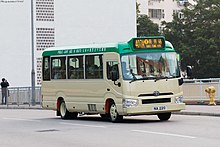- 1 2 3 "Minibuses". Transport Department. Retrieved 10 July 2023.
- ↑ "EPD - Problems & Solutions". www.epd.gov.hk. Retrieved 12 November 2021.
- ↑ "Transport Department – Minibuses". www.td.gov.hk.
- ↑ "Transport Department - Relevant Regulations of Public Light Bus". www.td.gov.hk. Retrieved 12 November 2021.
- 1 2 "Riots in 1967 sparked service by van owners". South China Morning Post. Retrieved 17 October 2008.
- 1 2 麥錦生 (2018). 搭紅VAN : 從水牌說起 : 小巴的流金歲月. 香港: 非凡出版. pp. 54–57. ISBN 9789888513475.
- 1 2 3 4 Since 1967: That Was Then (由1967開始) 1968-1969, TVB
- ↑ "舊式新界的士 - 香港文匯報". Archived from the original on 14 April 2015. Retrieved 10 April 2015.
- ↑ "TAC welcomes Government's plan to commence Public Transport Strategy Study". www.info.gov.hk.
External links
Wikimedia Commons has media related to Minibuses in Hong Kong .
| Public light bus | |
|---|---|
 A green minibus ('GMB') |
| Franchised | |
|---|---|
| Non-franchised | |
| Former | |